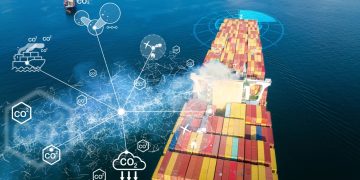In its latest safety digest, the UK MAIB describes a case of an offshore supply vessel collision with two smaller vessels, which sank as a result. MAIB stressed that the master had checked the thrusters were working by observing pitch movement, but technical investigation indicated that the thrusters’ electric motors were probably not started.
The incident
While alongside in a river port, starboard side to and head to stream, a 62m offshore supply vessel was shifting berth 100m astern.
It was a routine manoeuvre and the main engine, steering, and bow and stern thrusters were available.
After letting go the forward lines, the master noticed that neither of the thrusters were operating.
As a result, the bow was quickly set towards the middle of the river by the stream.
The river was only 75m wide, and with the stern lines and aft spring still connected the master was unable to control the vessel with only the main engine.
As a result, the stern lines tensioned and started to run off the bitts, prompting the aft mooring team to take shelter.
Meanwhile, the shore linesmen managed to let go the aft spring.
Although the deck crew tried to recover the spring inboard, there was a lot of line in the water and they could not prevent it from fouling the starboard propeller.
By that time, the supply vessel was very close to berths on the opposite bank and, although stern lines remained connected, the master had managed to keep the vessel head-to-stream.
However, he could not prevent it from colliding with two small moored boats.
Soon after, the thrusters were started and the master was able to manoeuvre the supply vessel back alongside its original berth. The two small boats sank.
Before the vessel started to slip, the master had checked the thrusters were working by observing pitch movement.
However, technical investigation indicated that the thrusters’ electric motors were probably not started.
Lessons learned
- The indication of pitch movement on electro-hydraulic thrusters shows only that the hydraulics are moving the propeller blades. It does not indicate that the thruster is turning. This is best achieved through physical tests with wash, the movement of mooring lines and thruster noise providing the most positive assurances.
- No matter how routine shifting berth might seem, the number of parties involved and the level of co-ordination required increases the potential for something to go wrong. To prevent this from happening, toolbox talks are a useful means of ensuring that everyone is aware of the task, the plan, the sequence of events, the crew and equipment required and the status of machinery. They can also be used to highlight risk factors such as tidal streams and snap-back zones.
- Each year, a number of seafarers are killed or seriously injured during mooring operations. However, although many occasions arise in which tensioning of mooring lines is unexpected and cannot be controlled, the fallback options of keeping out of snap-back zones and taking cover are tried and tested and are nearly always available.

































































